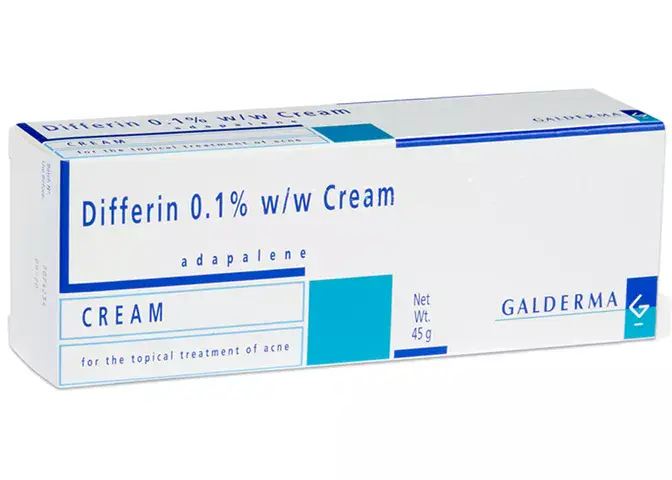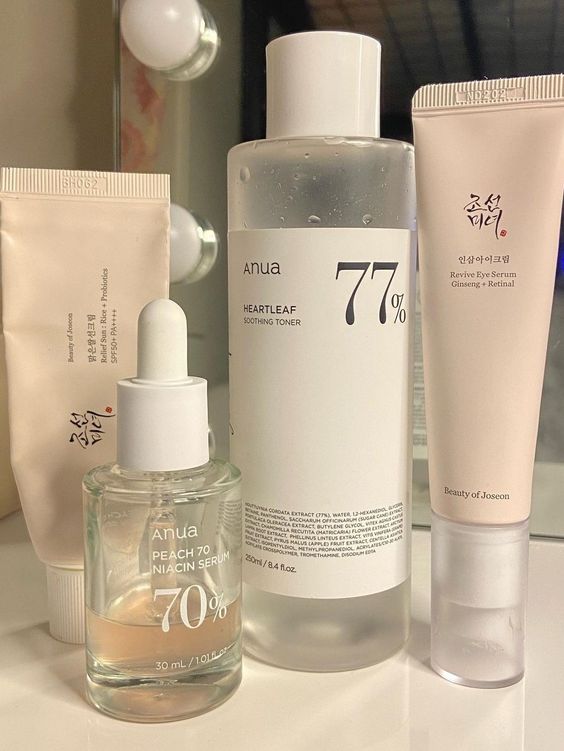This site contains affiliate links. I may earn a small commission, at no extra cost to you.
In this post we’ll discuss whether teens can use retinol to treat acne in their skincare routine.
What is retinol?

Topical retinoids are skincare products that target acne breakouts, fine lines, dark spots and skin texture. They usually come in a cream or gel formula and are able to improve tonnes of skin concerns. This is why they’re often prescribed to teenagers who’re suffering with skin conditions like acne..
There’s a common misconception that retinoids are only for anti-ageing, but they were actually originally made to be an acne treatment, making them ideal for teens. They work by increasing skin cellular turnover to clear acne.
What are the benefits of retinol?

Aside from reducing acne breakouts, retinoids can also target so many more concerns. This is why I talk about them so much in my videos, because I really feel they can do way more than most other skincare actives. In my opinion, if you can use retinoids, you often don’t need to use other things like salicylic acid, benzoyl peroxide or vitamin C.
Here are some more benefits of retinol:
- Retinoids can reduce oil production if used consistently over time. It does this by regulating the sebaceous glands that produce the oil.
- Fade brown spots: retinoids can fade sun spots as long as it’s used with SPF (retinoids should always be paired with proper sun protection).
- Enhanced collagen production: plumper skin is often a noticeable side effect of using retinoids.
- Reduced appearance of wrinkles: retinol is often marketed as an anti-aging ingredient because it is one of the most effective for.
- Reduced cystic acne and period-related breakouts
- A more even skin tone when paired with sunscreen
- A visible reduction of acne scars when paired with sunscreen
So, should teens use retinol?

With all of this broken down, there is no reason why teens shouldn’t be able to use retinoids. You might be surprised to find out that teens are regularly prescribed retinoids by their healthcare provider, they just aren’t called ‘retinoids’ when they’re prescribed. Later, we’ll break down the different types of retinoids so you can be aware if you’re being prescribed one, but in general most acne treatments prescribed by doctors for teenagers are from the retinoid family.
If you’re concerned about anti ageing, there is no ‘best age’ to use retinoids, but the general consensus is around 23-26 is a good time to start the use of retinol. Whatever you do decide to do, make sure you’re using it with a broad-spectrum sunscreen to protect your skin from premature aging and the UV rays of the sun.
If you’re under the age of 18 (and even if you’re in your early twenties) it might feel safest to you to go to your doctor for your retinoid acne medication, rather than going into a shop and buying it yourself. Even though there’s nothing wrong with buying it yourself, there is a big difference between the topical acne treatments in shops like Boots and Walmart than the ones you’re doctor can prescribe you.
The different types of prescription retinoids
There are a few different kinds of prescription-strength retinoids that your doctor might give you. As the name suggests, you can only get these from a doctor, board-certified dermatologist or an online service like Dermatica, Skin & Me or Apostrophe etc.
Since prescription retinoids contain such a powerful ingredient (vitamin A/retinoic acid), you cannot buy these in a store without a prescription. The only exception that I’m aware of is in certain countries such as Mexico, where I hear they sell things like Tretinoin easily in pharmacies. Lastly, Adapalene (also known as Differin) is available online from some pharmacies in the UK and US.
Tretinoin

Tretinoin is one of, if not the, oldest retinoids ever created. It therefore has many years of studies behind it, where scientists have studied people for their whole lives who’ve used it. It is widely known to be very safe, even though it has a scary name. Originally created as an acne treatment, these studies revealed that people who used tretinoin for a long time also happened to age very well. This is how we discovered its ability to increase elastin production and reduce the appearance of fine lines.
As with all of these examples, tretinoin is a topical treatment, meaning it is designed to be spread across the entire face, not taken orally like a tablet or used as a spot treatment. Tretinoin comes in a range of strengths from 0.015% (less common) to 0.5%. Don’t be fooled by the numbers, this is one of the strongest retinoids available.
Adapalene (Differin)

Adapalene is another topical acne treatment that is becoming more and more popular in recent times. It is a third generation retinoid, meaning it’s a little newer than tretinoin. One of the main benefits of using adapalene is that it has been shown to target acne specifically very effectively, and come with less skin irritation than tretinoin.
Again, it is a topical medication designed to be used across your whole face, not as a spot treatment. It is particularly great for acne-prone skin and young skin.
Epiduo
Epiduo is another very common prescription retinoid in the UK especially, often prescribed as a good option for teens and young adults with inflammatory whiteheads and papules. It is made up of a combination of adapalene and benzoyl peroxide. Benzoyl peroxide is not a derivative of vitamin A, meaning it is not a retinoid by itself, but the combination of adapalene and benzoyl peroxide together make Epiduo a retinoid treament.
Benzoyl peroxide is added to adapalene because it helps to kill acne-causing bacteria. On its own it doesn’t target signs of aging or skin cell turnover, but when the Epiduo formulation as a whole does. Sometimes a doctor will start you on Epiduo to get the acne under control, and then move you onto just adapalene once the acne is doing much better.
Side effects of retinol on teenage skin

There are some known side effects of retinoids that generally don’t differ between adult or teenage skin. Whether you have dry skin, oily skin or balanced skin, most people will go through what’s called a ‘purge‘ to begin with, especially if they already deal with acne.
A purge is due to the sped up skin cell turnover, and it really just means that your skin may get a little worse before it gets better. The good news is that, once the ‘purge’ is over, most people who use retinoid products will see much clearer skin for as long as they use it.
Here are some more possible side effects of retinol:
- Increased sun sensitivity. Whether you’re currently wearing the retinoid or not, your skin may burn more easily when using a retinoid. Be sure to stay out of direct sunlight for too long and wear sunscreen. Never try to tan!
- Dry, flaking or peeling skin
- A little more redness than usual, as your skin adapts to the retinoid
These side effects can happen with most retinoids, even over-the-counter retinoids and lower strength concentrations. There is normally always a period of adjustment and it can take up to 12 weeks for them to stop. I personally noticed the best results from my retinoid after about 9 months.
Ingredients to pair with retinol

In general, retinoids are known to increase the skin’s sensitivity, so it’s a good idea to make sure you use a gentle cleanser and have an overall calming routine. You don’t want to be overdoing it with other active ingredients like lactic acid, alpha-hydroxy acids or physical scrubs.
Especially in the teenage years, you want to create a simple yet reliable routine that focuses on just one or two active ingredients to tackle your acne.
Here are some ingredients that pair nicely with a retinoid for teenagers:
- Hyaluronic acid
- Ceramides
- Centella asiactica (cica)
- Madecassoside
- Azelaic acid (although this is technically an acid, it is very gentle and anti inflammatory)
- Panthenol
- Glycerin
These are all particularly good for a sensitive skin type. Check our my recommendations If you’re looking for gentle cleansers, moisturiser recommendations or barrier serums to pair with retinoids.
Retinoid skin care routine mistakes to avoid
Retinoids are so powerful when used correctly, but there are a few mistakes you should avoid for a better experience.
- Do not use a retinoid while you’re pregnant, as it can cause deformities to the baby.
- Do not use a retinoid on your lips or eyes, and make sure to avoid these areas by at least 0.5cm margin when you apply, as the retinoid product does travel once applied.
- Don’t use your retinoid with glycolic acid (or any kind of AHA), vitamin C or salicylic acid.
- Only use luke warm water to cleanse with, not hot!
- Be sure to check that your cleansers don’t contain chemical exfoliants before you start, or risk causing irritation.
- Don’t overdo it with sun exposure – you’ll regret it! Wear a hat over your face if you do sunbathe.
- Give the retinoid at least 2-3 months to show signs of working. Way too often people come to after a couple of weeks and things have only gotten worse.
This post discussed whether teens should use retinol products for acne in their routine.
You may also like:
- How to get rid of clogged pores (and four mistakes to avoid!)
- The best sunscreens for clog prone skin